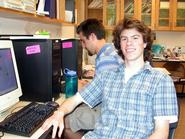
Three Hamilton students and a Hamilton alumnus are working with Winslow
Professor of Chemistry George Shields and Visiting Assistant Professor
of Chemistry Karl Kirschner to continue long-term research on an
enediyne anti-cancer project. Frank Pickard '05 (Escondido, Calif.)
Tumie Gopolang '08 (Orapa, Botswana) Evan Savage '08 (Delmar, N.Y.)
Jovan Livada '08 (Belgrade, Yugoslavia) are researching esperamicin A1
in the enediyne family in their project titled "Exploring Bergman
Cyclization Energy Barriers in Esperamicin A1."
"Esperamicin A1 is a member of a family of naturally occurring
compounds known as enediynes," Pickard explains. "Enediynes have drawn
a large amount of interest as anti-tumor drugs because of their
incredible ability to cleave DNA, and kill cells." However, these
compounds indiscriminately kill both healthy and cancerous cells.
Therefore, the students are exploring ways of modifying the compounds
to be more selective towards eliminating the cancerous cells and
leaving the healthy cells alone.
Pickard and his peers are
attempting to computationally model the chemical mechanism responsible
for esperamicin's bioactivity in their summer project. "Our summer
research has focused on activation energies and cyclization energies of
this compound," Evan Savage explains. "There is a region of the
esperamicin A1 molecule called the "warhead" which, when triggered,
undergoes a process called Bergman Cyclization in which a diradical
intermediate is formed. From here, two hydrogens are abstracted,
creating a benzene ring," he explains.
"By modeling this
reaction, and understanding the mechanism, we can gain insight into how
to chemically modify the naturally occurring esperamicin molecule into
an effective and safe anti-cancer drug," Pickard explains. The group
hopes to understand this process. "If this were to occur, maybe it can
be well controlled and can be used to effectively treat cancer," Savage
adds.
Pickard, the group leader, has extensive research
working in Shield's lab. Pickard has worked in Professor Shields' lab
during the summers of 2003 and 2004; he also has already done extensive
research on the subject, as esperamicin research was the topic of his
senior thesis.
"This topic is interesting to me because it
provides a unique challenge," he explains. "Modeling biological systems
using quantum mechanics requires a daunting amount of computer
resources (some simulations run on our massive vending machine sized
computers for weeks)." Pickard says that figuring out ways of
performing highly accurate theoretical simulations, while
simultaneously keeping the calculations simple enough so that the
computer can perform them before the deadline is the most challenging
part of this project. "It's a balancing act," he admits, but well worth
any of the stress.
Pickard majored in both chemical physics
and math at Hamilton. Although Gopolang, Savage, and Livada have not
yet needed to declare a major, they are all looking into chemistry as a
possible concentration.
-- by Emily Lemanczyk '05
Posted August 1, 2005
